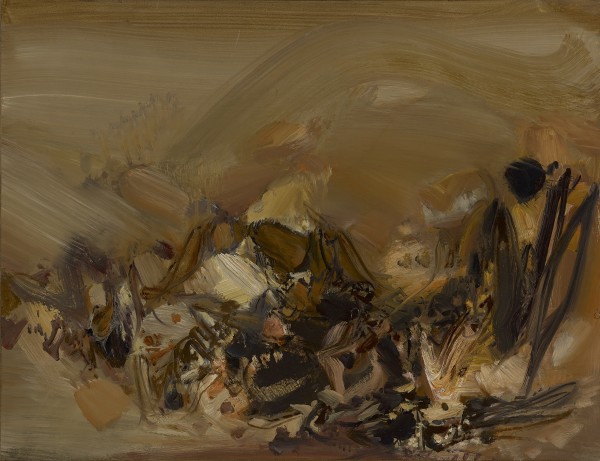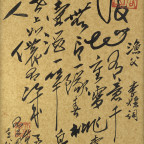Biography
Waddington Custot is pleased to present an exhibition by one of the leading Chinese abstract artists of the twentieth century, Chu Teh-Chun (1920–2014). Through the presentation of 45 works on paper from private collections, including calligraphy, gouache, oil and ink, the exhibition will explore the diversity of Chu Teh-Chun’s practice and his iconic aesthetic which contributed significantly to the Chinese modernist movement in France. Presenting the artist’s calligraphy in the United Kingdom for the first time, the exhibition will investigate the classical Chinese tradition that continued to form the core of his practice.
Chu Teh-Chun began his artistic training at National Academy of Fine Arts, Hangzhou, which at the time was overseen by Lin Fengmian, the first student painter to receive a government scholarship to study fine arts in France. Chu moved to Paris in 1955 and, being particularly moved by the layered forms, colours and impasto of Nicolas de Staël’s work, began to reassess his own approach to making work. Rather than ‘Westernising’ Chu’s technique, it encouraged him to discover ‘abstract’ elements within his own Chinese painting tradition. He developed his own stylistic language, melding his training as a calligrapher and a painter to create works which intricately coalesce both mediums. His paintings, which are vibrant and full of movement, were heavily influenced by the strong brushstrokes of the calligraphic line and have a profound sense of depth, poetry and musicality.
Although predominately abstract, Chu’s work employs the dramatic movement and forms of imagined landscapes. These landscapes do not seem rooted in a particular place, but draw upon Chu’s extensive travels to Hong Kong, Vietnam, Sri Lanka, Egypt. Oil works including ‘Untitled’, 1970, utilise the traditional vertical emphasis of Chinese landscape painting with a suggestion of a looming mountain in the top corner of the picture. This soon dissipates at the bottom of the painting where solid reality filters into wild, suggestive brushstrokes, abstracted light and shade of colour.
Chu’s work on paper reflects his passion for ancient Tang and Song dynasty poetry, calligraphy and literati painting. In presenting the artist’s calligraphy, alongside his paintings on paper, the exhibition brings together this trinity which, in the Chinese tradition, is inextricably linked. The linear mark-making and layering of Chu’s work reflects the dynamic rhythm of his running script calligraphy, and his ink washes are predominately executed in black but are highlighted by the occasional use of red or green. This striking use of colour is echoed in his gouache and oil work, which generate sources of light within a dark and atmospheric natural environment.
The exhibition will shed light on the breadth of Chu Teh-Chun’s practice and suggest that, rather than adopting the ideals of Western painting, Chu’s move to Europe encouraged him to discover and embrace these resonating elements already within the Chinese artistic tradition.
NOTES TO THE EDITORS
Chu Teh-Chun was the first person of Chinese ethnicity to become a member at the Académie de Beaux-Arts, Paris. He was later invited to become a lifelong member of the Institute de France in 1999. In 2001, he was awarded the Chevalier de l’Ordre des Palmes Académiques and Chevalier de la Légion d’Honneur, and the European Gold Medal of Merit by the European Commission in 2006.
He held his first solo exhibition at Galerie Haut-Pavé, Paris in 1958. Since then, his work has been shown throughout galleries in France and internationally at Galerie Baier, Germany (1962); Galerie Latzer, Switzerland (1965); 10th São Paulo Biennial, São Paulo (1969); Antiope Gallery, Sorrento, Italy (1977); Institute of Hong Kong for the Promotion of Chinese Culture, Hong Kong (1986); Dimensions Art Gallery, Taiwan (1993); Shanghai Museum, Shanghai (2000); and Marlborough Gallery, New York (2008, 2014).Retrospectives of his work have also been shown at Taipei Museum of Natural History, Taiwan (1987) and at National Art Museum of China, Beijing (2010).
Chu Teh-Chun’s work can be found in a range of private and public collections including Bibliothéque Nationale, Paris; Direction du Centre hospitalier de Brunet, Toulon; Guangdong Museum of Art, Guangzhou, China; Maison de la Culture de la Société des Eaux, Marseille; Musée des beaux-arts André Malraux, Le Havre, France; Musée Cernuschi, Paris; National Museum, Dhaka, Bangladesh; National Library, Bogotá; Shanghai Museum of Art, Shanghai; and Shanghai Opera House, Shanghai.
Read more-
 Chu Teh-Chun, Untitled , 1970
oil on paper laid down on canvas
19 3/4 x 25 5/8 in / 50 x 65 cm
%3Cdiv%20class%3D%22artist%22%3E%3Cspan%20class%3D%22artist%22%3E%3Cstrong%3EChu%20Teh-Chun%3C/strong%3E%3C/span%3E%3C/div%3E%0D%3Cdiv%20class%3D%22title%22%3E%3Cem%3EUntitled%20%3C/em%3E%2C%201970%3C/div%3E%0D%3Cdiv%20class%3D%22medium%22%3Eoil%20on%20paper%20laid%20down%20on%20canvas%3C/div%3E%0D%3Cdiv%20class%3D%22dimensions%22%3E19%203/4%20x%2025%205/8%20in%20/%2050%20x%2065%20cm%3C/div%3E
Chu Teh-Chun, Untitled , 1970
oil on paper laid down on canvas
19 3/4 x 25 5/8 in / 50 x 65 cm
%3Cdiv%20class%3D%22artist%22%3E%3Cspan%20class%3D%22artist%22%3E%3Cstrong%3EChu%20Teh-Chun%3C/strong%3E%3C/span%3E%3C/div%3E%0D%3Cdiv%20class%3D%22title%22%3E%3Cem%3EUntitled%20%3C/em%3E%2C%201970%3C/div%3E%0D%3Cdiv%20class%3D%22medium%22%3Eoil%20on%20paper%20laid%20down%20on%20canvas%3C/div%3E%0D%3Cdiv%20class%3D%22dimensions%22%3E19%203/4%20x%2025%205/8%20in%20/%2050%20x%2065%20cm%3C/div%3E -
 Chu Teh-Chun, Untitled, 2008
China ink on Kraft paper
14 7/8 x 13 1/4 in / 37.7 x 33.5 cm
%3Cdiv%20class%3D%22artist%22%3E%3Cspan%20class%3D%22artist%22%3E%3Cstrong%3EChu%20Teh-Chun%3C/strong%3E%3C/span%3E%3C/div%3E%0D%3Cdiv%20class%3D%22title%22%3E%3Cem%3EUntitled%3C/em%3E%2C%202008%3C/div%3E%0D%3Cdiv%20class%3D%22medium%22%3EChina%20ink%20on%20Kraft%20paper%20%3C/div%3E%0D%3Cdiv%20class%3D%22dimensions%22%3E14%207/8%20x%2013%201/4%20in%20/%2037.7%20x%2033.5%20cm%3C/div%3E
Chu Teh-Chun, Untitled, 2008
China ink on Kraft paper
14 7/8 x 13 1/4 in / 37.7 x 33.5 cm
%3Cdiv%20class%3D%22artist%22%3E%3Cspan%20class%3D%22artist%22%3E%3Cstrong%3EChu%20Teh-Chun%3C/strong%3E%3C/span%3E%3C/div%3E%0D%3Cdiv%20class%3D%22title%22%3E%3Cem%3EUntitled%3C/em%3E%2C%202008%3C/div%3E%0D%3Cdiv%20class%3D%22medium%22%3EChina%20ink%20on%20Kraft%20paper%20%3C/div%3E%0D%3Cdiv%20class%3D%22dimensions%22%3E14%207/8%20x%2013%201/4%20in%20/%2037.7%20x%2033.5%20cm%3C/div%3E











